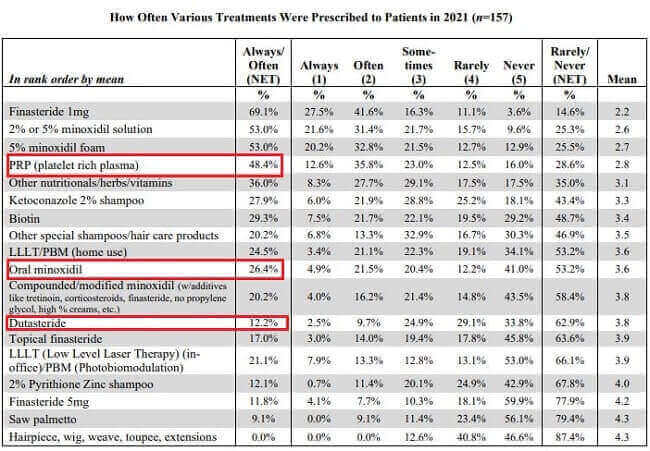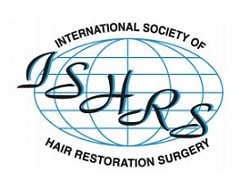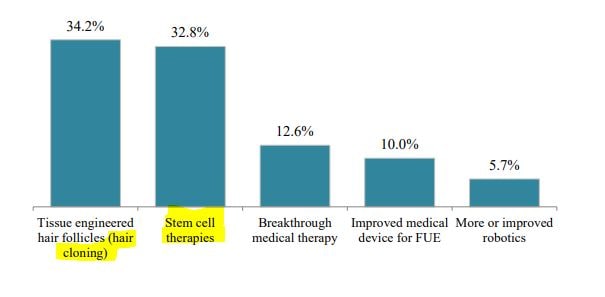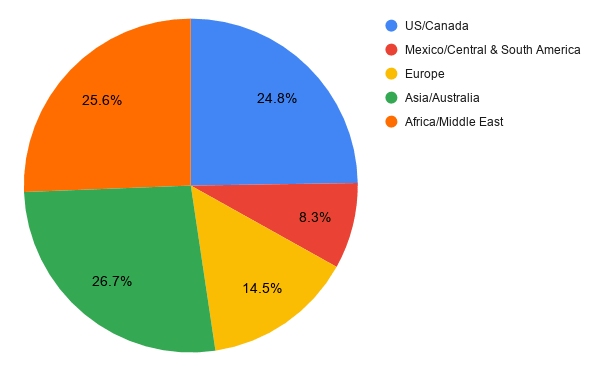The International Society of Hair Restoration Surgery (ISHRS) publishes its practice census results every two years. I covered the 2020 one with worldwide hair transplant statistics in detail. Now its time for an update due to the release of 2022 data.
ISHRS 2022 Census Results
In April 2022, the ISHRS published its latest Practice Census results (covering 2021 data). It sent out the survey to its 858 Physician members, but only 197 replied back in time. Nevertheless, still some very useful findings. It seems like ISHRS membership declined from 929 to 858 during the past two years.
After extrapolations, the ISHRS estimated that 703,183 hair restoration procedures were performed worldwide in 2021. I always assume that the real number is much higher after including back-alley and unregistered hair transplants abroad in countries such as Turkey and India. The vast majority of hair transplants in the world are not performed by ISHRS members. In most countries, doctors and plastic surgeons often perform a few hair transplants every month as a “side gig” to their main practice.
Among the most interesting findings is that hair transplant surgeons are increasingly performing just one procedure per patient. Just a few years ago, it was common to perform 3 small procedures per patient.
Larger hair transplant megasessions of 3,000 to 5,000 grafts are now extremely common. Some surgeons are even performing gigasessions on rare occasions. Of course most patients will likely still need a second procedure in 10 plus years as their hair loss progresses.
Another important (but not surprising) finding is that Zoom and other methods of video communication have made people much more self-conscious about their hair loss. The so-called “Zoom effect”. I am glad that at my current workplace, no-one turns on their videos during Microsoft Teams calls.
The ISHRS hair restoration trends infographic has more interesting findings. I covered hair transplant surgery statistics in detail when the last 2020 census came out (keep scrolling for original post). This time, I only want to focus on this one table:

From the above table and earlier infographic, I find the most interesting developments to be:
- The percent of surgeons always or often prescribing oral minoxidil to treat hair loss rose from 10% in 2019 to 26% in 2021.
- The percent of surgeons always or often prescribing dutasteride to treat hair loss rose from 6% in 2019 to 12% in 2021.
- Almost one-half of all ISHRS members often recommend PRP for hair growth. This is surprising, but perhaps PRP does work at least modestly in most people. Even if just imperceptible to the naked eye hair follicle thickening.
July 4th, 2020
Hair Transplant Statistics 2020

Recently, the International Society of Hair Restoration Surgery published its 2020 census results. There are some very interesting hair transplant related findings presented in the summary.
However, the most interesting findings to me are those unrelated to hair restoration. Scroll through the end of this post to read about all the details.
The previous ISHRS census came out in 2017.
Future Treatments
My favorite question is on page 25: “What do you think will be the next technological “leap” in hair restoration?”
Out of 929 surgeons who were e-mailed this survey, only 201 surgeons answered this question. Hair cloning and stem cell therapies were the most popular responses:

How Many Hair Transplants Each Year?
Only 270 hair transplant surgeon members responded in time to this main survey question. After extrapolation and adjusting for anomalies, the ISHRS estimated that 735,312 hair restorations procedures were performed worldwide in 2019. This number represents a 16 percent increase from 2016, when an estimated 635,189 hair transplant procedures were tallied globally.
World Hair Transplant Surgery Totals by Region, 2019

Data Accuracy
Whenever I see such survey results, I am always highly skeptical about the annual global hair transplant totals. Although the ISHRS has around 1000 members across 70 countries, there are likely several thousand surgeons in developing countries who do not join this organization.
Many of these “missing” surgeons offer hair transplants as a side offering at their general cosmetic surgery and dermatological practice. And many hospitals have surgeons who perform hair transplants infrequently. e.g., during emergencies such as burning accidents or scalp injuries.
This under-representation is even more exaggerated when you consider the numerous sketchy “roadside” hair restoration clinics in many developing countries. Most of these assembly line type clinics would likely not even get ISHRS membership applications approved.
Moreover, many legitimate clinics and surgeons in poorer countries cannot afford to join the ISHRS and pay annual dues. And many probably do not deem it worth joining a US headquartered organization. Especially if most of their local clients do not care about certifications and international association memberships.
I would therefore not be surprised if the actual number of hair transplant procedures that take place worldwide is closer to 2 million or even higher. The ISHRS totals for vastly populated China and India are likely heavily underestimated. The cost of a hair transplant in these countries is a small fraction of that in the developed world.
Moreover, an increasing number of studies and articles suggest that rates of balding in China and India have gone up significantly in recent years. I think that there is also significant underestimation when it comes to places such as Turkey, UAE (Dubai) and Thailand. In fact, a number of online news articles from reputable sites suggest that 100,000 hair restoration procedures take place in Turkey alone every year.
However, before booking a flight, make sure to read my post on the dangers of getting a hair transplant abroad.
Other Hair Transplant Statistics
Among the other interesting hair transplant statistics and related findings in this census/survey include:
- An 85 percent to 15 percent split in the male versus female share of the hair transplant clientele. Not surprising.
- A 66 percent “FUE only” versus 30 percent “FUT (strip) only” procedure type performed division. Also not surprising to me. See my past post on FUE versus FUT. The vast majority of FUE procedures are performed by motorized techniques, usually without suction.
- Robotic-assisted FUE represents only 5.3 percent of all FUE procedures performed in the world.
- 99 percent of FUE surgeons used punches of less than 1 mm size. No-one used punches of less than 0.8 mm size.
- When it comes to FUE donor sites: 92.5 percent included scalp hair; 7.5 percent included beard hair; and 2.4 percent included chest hair. Body hair transplants (BHT) are therefore still not very popular.
- 57 percent of patients needed only 1 procedure to achieve their desired result. A bit surprising to me. However, my guess is that many of these satisfied customer will eventually come back for a second procedure after some years due to further hair loss.
- 81 percent of patients have between 1000-3000 grafts transplanted during their first procedure.
- 87 percent of patients were between the ages of 26 and 45.
- Only 13.4 percent of hair transplant surgeons’ patients came from a different country.
Present Hair Loss Treatment Survey
Another great section also does not involve any hair transplant statistics.
On page 16, there is a table titled: “How Often Various Treatments Were Prescribed to Patients in 2019“. 204 surgeons responded to this question. Not surprisingly, Finasteride and Minoxidil were by far the most popular treatment recommendations.
These two are the only ever FDA approved medications to treat androgenetic alopecia (aka male pattern baldness). The Finasteride recommendation breakouts in the table were split into 1% and 5% doses; as well as a separate topical Finasteride category.
I was surprised by the following findings:
- A higher than expected 10.2 percent of responding physicians stated that they “always or often” prescribed oral Minoxidil to treat hair loss. In my past post on oral Minoxidil, I mentioned how it was become increasingly popular in Australia and Thailand. I would be nervous about the side effects of taking such a medication to treat high blood pressure. Especially a potential increase in body hair. However, it seems like many hair loss sufferers are biting the bullet and hoping to get superior results to topical Minoxidil.
- Only 5.9 percent of the doctors “always or often” prescribed Dutasteride to treat hair loss. Very low in my opinion. Almost all comparison studies show that Dutasteride is superior to Finasteride in treating hair loss. But the former also has greater rates of side effects. It seems like hair transplant surgeons are reluctant to prescribe Dutasteride off-label to treat pattern hair loss. Even natural DHT blocker Saw Palmetto was recommended as a hair loss treatment more frequently (8.5 percent) than Dutasteride.
- Around 30 percent of patients were often recommended to take natural supplements, vitamins, herbs and Biotin. Nutritional deficiency related hair loss is not common, and is usually temporary in nature. So this number is higher than I would expect.